Introduction:
Some of the bigger suppliers, manufacturers and distributors offer paving in packs of single sizes, so it is possible to buy, for example, individual crates containing just one size of product, whether it's a 900x450mm flagstone, a 100x100x30mm sett or anything in between.
Special features, such as circles and fancy centrepieces, have typically been supplied in a single pack (or a couple of packs) for many years.
However, more and more manufacturers, importers and distributors are supplying everyday paving in so-called 'Project Packs, or 'Patio Packs' where each crate or pallet of paving contains a pre-determined number of specified sizes.

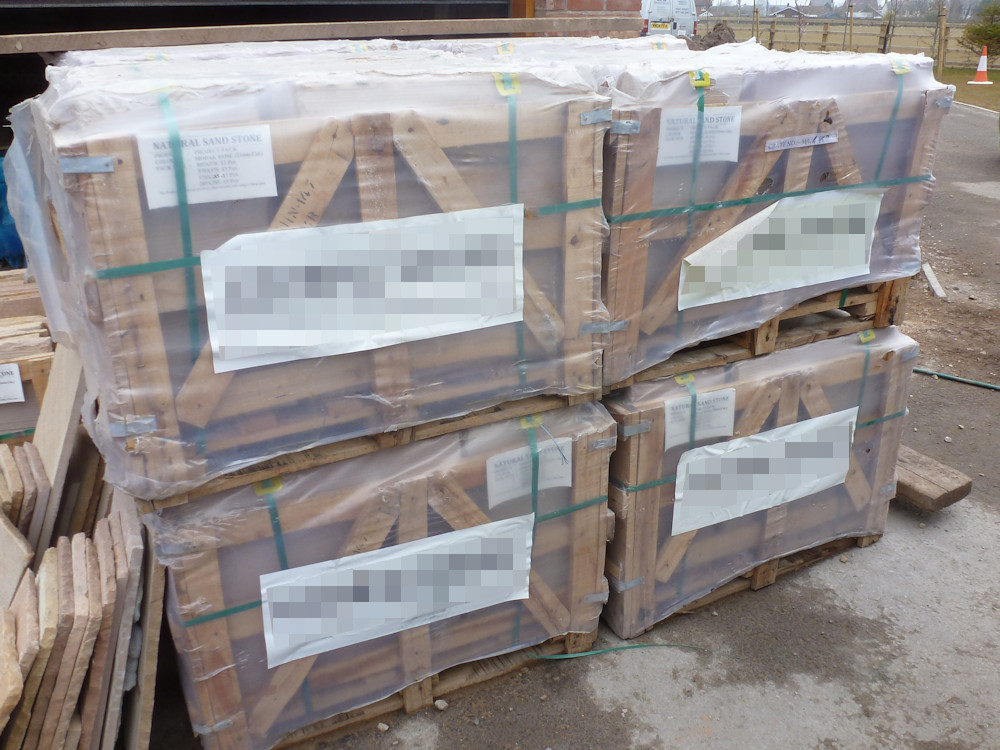
There is the inevitable claim that this is what customers require, but the real driving force is the huge buying power wielded by a small number of bone-idle, greedy retailers who don't want to get involved in splitting crates of single sizes to fulfill an order. They just want to grab the dosh while foisting a pre-selected pack format onto the buyer: maximum profit for minimum effort and buggerall customer service.
Pros and Cons:
To be fair, there are numerous pros and cons to these Project Packs. Economics are such that it generally works out cheaper to buy hard-landscaping in such packs unless you have a project larger than around 250m² at which point it becomes slightly cheaper to buy individual packs - see worked examples below . This is why some projects on a tight budget are done in flags all of one size.
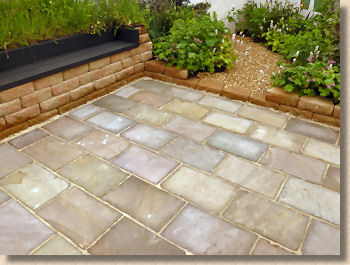
But saving a few quid also means losing control over just how many of what sizes are available to you. For clients and contractors with specfic requirements, such as those not wanting to include any or many of the smaller 275x275mm or 300x300mm units, the Project Packs are rarely a sensible option. You get what you are given.
It's worth noting that some retailers, usually specialist paving suppliers with a yard rather than dealers with nothing more than a web-based presence, do offer a good standard of service and will gladly 'pick' an order for their clients, choosing exactly the right number of the selected sizes, ensuring choice remains with the client. It's often worth paying a small premium for such a level of service as such suppliers are more customer-focussed, and by indvidually picking each order, the yard staff can sling out the occasional flag or sett which may have a broken corner, or just be a bloody ugly piece of stone.
Identifying good Project Packs
Once it's been determined whether Project Packs are a suitable proposition for any particular job, the next question is how to tell whether any particular Project Pack is actually any good.
When considering Project Packs, pay close attention to the number of sizes included and the quantity of each size. The best Random Layouts are constructed using six or more modular sizes. Project Packs offering only three or four sizes limit the degree of randomness that can be created.
Also, be wary of any packs which offer a large number of smaller sizes. These smaller pieces are often cheaper per square metre than larger flagstones, and so some suppliers pad out a pack with umpteen little 'uns because it keeps costs to a minimum. The downside is that too many of these smaller pieces results in a bitty looking layout, and in some cases, the quantity of small flags is bordering on the ridiculous.
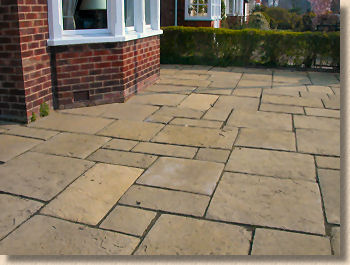
In a good Project Pack there will be at least four sizes. Remember: more sizes make for better random layouts; fewer sizes may be better laid as coursed layouts.
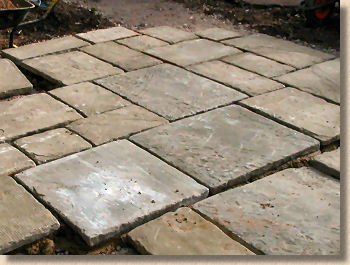
There should also be more oblongs* than squares. This is critically important for random layouts. Some Project Packs offer only three sizes - 300x300, 300x600 and 600x600mm - this mix of two square and only one oblong severely limts the layout possibilities.
*Oblongs are rectangles where the length is not the same as the width. Squares are rectangles where length and width are the same. We use the term oblong rather than rectangle to aid clarity. Many contractors will refer to flagstones where the length and width are different as rectangles. This is technically true; they are indeed rectangles, but then so are the square flags!
The best Project Packs will include a number of flagstones which are 'half modules'. For flagstones of the 560 series , this means pieces that are 280x280 or thereabouts; for flagstones in the 600 series , these will be 300x300mm units. The inclusion of half-module flags enables good layout development. If the job requires a random layout, be wary of those packs which offer only a single gauged size - where all pieces have one dimension in common. Although it is usually possible to design a random layout using such packs, it's never particularly easy and the resulting design isn't quite as pleasing to the eye as those utilising 'half-module' pieces.
Some popular Projects Packs
The following tables show the contents of a selection of readily available Project Packs from a range of suppliers, with comments on the make up of each pack.
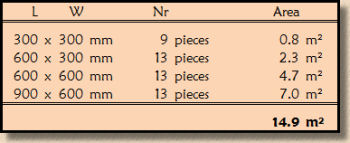
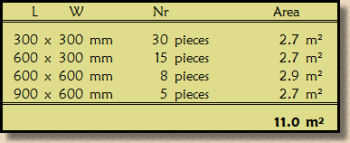
A popular pack format, with slightly fewer small pieces, but when laid out, the largest size dominates
Auction site alleged bargain - but look at all those tiddlers! That's why it's so cheap.
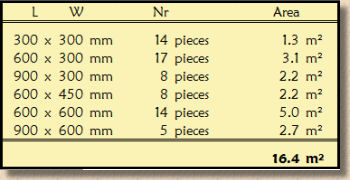
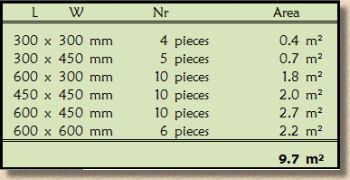
A more generous six-size mix, but too many of the smallest size can result in a bitty appearance. There's a generous spread of sizes, from 300 to 900mm, but by having only one size with a 450mm dimension, this will require two such units to be paired to round-up to the basic 300mm module.
Another six-size offering, but more skewed towards DIY-friendly smaller sizes, with nothing bigger than 600mm. Two sizes have 450mm dimensions, which massively increases design versatility. A good distribution with a few of the small pieces, a few of the largest, and more of the middling sizes.
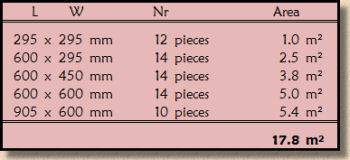
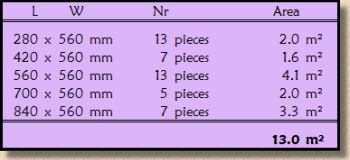
A five size mix with fewer small/large pieces, but again only one size with a 450mm dimension which limits design possibilities
A strange mix of five sizes. No half-modules, so random layout design is restricted, but an excellent choice for coursed layouts
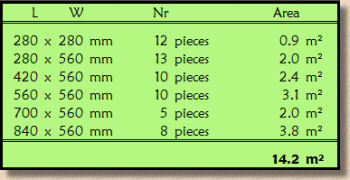
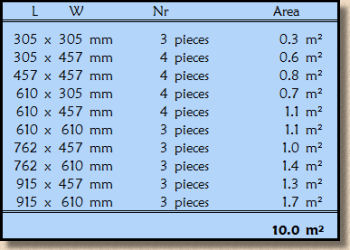
Plenty of choice from six sizes, but there's a lot of little 'uns and quite a few big 'uns. The inclusion of 700mm units enhances versatility, but a ratio of roughly two squares to three oblongs means careful planning is needed.
The ultimate in size choice, with a whopping ten sizes which can create superb random layouts with ease.
Jointing included?
This is not a huge issue, but one of which customers should be aware. The overwhelming majority of suppliers quote a coverage figure for their Project Packs that includes the area covered by the hypothetical jointing. The packaging may state, for example, that the pack will cover 12 square metres, but that is NOT the same as saying that there is 12m² of paving in the pack. It simply, and slightly misleadingly, means that, if the contents of the pack were to be laid out with the joint width suggested by the manufacturer, it will achieve the stated coverage.
Is this a bad thing? Well, firstly, the customer is being sold a 'serving suggestion'. The paving, if laid butt-jointed , would not cover quite as large an area as that claimed by the supplier. The legalities of this are open to interpretation, especially because a less honest supplier could claim that their Project Pack achieved a coverage of 12m² but in reality this could only be done if the paving was to be laid with ridiculous 50mm wide joints.
The problem is that, once one of the big suppliers starts to flog their Project Packs on this basis, everyone feels obliged to follow suit, and so although a pack may state 12m², the customer actually receives roughly 5% less (on average) as there will only be around 11.4m²
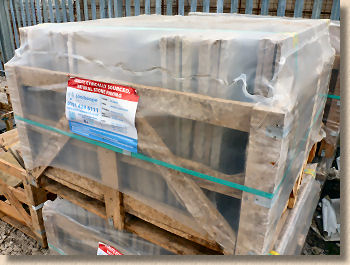
This should not be a problem if the packs are bought on the basis that the joint width will be the same as that quoted by the supplier. When a client elects to use butt- or close-jointing, there's a small risk of running short of paving. If this happens to you, prepare to be wowed by the bluster and bovine excrement wafted beneath your nose by both supplier and retailer.
Economy vs. Versatility
It's usually cheaper to buy single size packs than multi-size project packs, but then if you want a reasonable 6-size mixed layout, that will require 6 crates of paving at an average of, say, 15m² per crate totalling 90 square metres of paving.
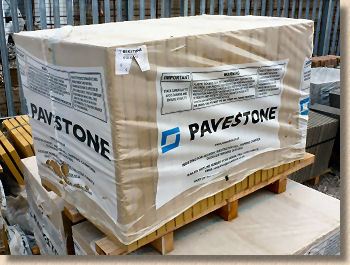
On smaller projects, it just isn't economic to buy individual sizes. If we accept that a random layout needs at least 4 different sizes to render it attractive, that would involve buying (4 @ 15m²) 60m² of paving. That's not feasible if the patio in question is only 25m²
Further, because crates of individual sizes are all roughly the same weight (or area), a crate of, say 300x300mm flagstones contains far more pieces than would a crate of 900x600mm flagstones, so buying a crate of each size would result in a preponderance of smaller sizes and few of the larger, resulting in a not very attractive layout when laid.
A large contractor may hold stock of several crates of each of size and pick from those crates to suit each individual project, but for smaller contractors, landscapers, and DIYers, Project Packs offer the most effective way of obtaining a reasonable mix of sizes, in reasonable quantities at a reasonable price.
Consider two projects...25m² and 250m²

To acquire four different sizes would normally require the purchase of four crates each of a single size, giving far more paving than is actually needed, and ramping-up the cost, as can be seen from Table 1 above. In such a scenario, using Project Packs is the obvious route to choose.
However, once the scale of a job increases, or for contractors willing to hold stock for use on subsequent jobs, there can be a slight economic advantage to buying crates of single sizes, as shown in Table 2 below.

NOTES: The prices and quantities used to compile the above tables were provided by a large online supplier during the summer of 2013. Prices shown don't include VAT or delivery, and are used purely as an example.
Selecting a source:
There's a lot to choose from out there, so take time to look around at the various options. The same stone, often under a plethora of different names, may be available in 4, 5, 6 or 10 size Project Packs, in 5m² mini-packs or on 18m² mega-packs. A similar situation exists with concrete flags, although it's important to recognise that specific brands are usually exclusive to one particular manufacturer. However, if choosing, say, a riven effect or shot-textured concrete flagstone, many of the large manufacturers will have their own version of such flagstones and it may be that they offer a Project Pack with constituents that better suit the job in hand.
Also, bear in mind that the big brands have a phenomenal range of products but it's not always possible for any one supplier to carry everything.
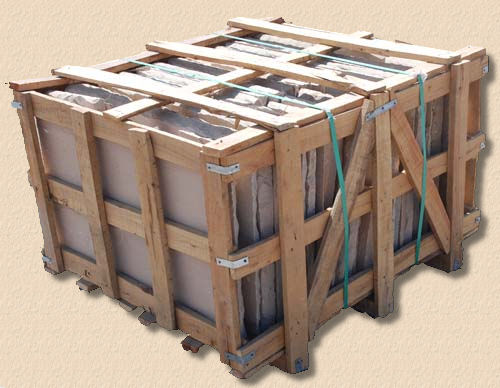
Don't expect your local garden centre to carry much more than basic project packs and possibly a selection of decorative aggregates. DIY sheds offer basic, popular products at a keen price. Builders' Merchants tend to offer a wider choice but many have exclusive arrangements with one particular company and so you don't always get a full view of what's available. Specialist hard-landscape suppliers will often carry stock from a range of companies as long as there is no obvious overlap.
Obviously, the interweb is your friend as it allows you to explore the contents of umpteen yards, warehouses and showrooms without leaving the armchair, but when making a final decision, it's ALWAYS worth going to see the product 'in the flesh', even if it's at the premises of a supplier you don't intend to use, as the true character, colour and texture of any paving is practically impossible to assess from images on a computer screen.

